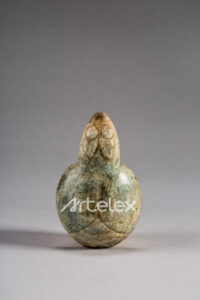Crafted from mossy green jade, this sculpture has aged over time, with areas showing signs of whitening. The overall form suggests an insect: a rounded head with bulging eyes, a convex upper body shaped like a dome, and a flat base. While there are no detailed elements such as legs, antennae, or distinct segmentation, the markings along its back hint at wing structures, suggesting a resemblance to a beetle.
Due to the lack of anatomical precision, the identification of the creature is ambiguous. However, it closely resembles the scarab beetle, a form widely used in Ancient Egyptian symbolism. Scarabs were associated with regeneration, protection, and the sun god Khepri, who rolled the sun across the sky like a beetle rolling dung. Scarab amulets were mass-produced in Ancient Egypt from stone, faience, or glass, used as beads, seals, and burial charms.
Unlike the Egyptian scarabs, this jade piece is entirely unique, with no direct counterparts known in either Chinese or Western archaeology. Its simplified yet evocative style invites both spiritual interpretation and comparative cultural study, particularly in relation to the broader iconography of insect-shaped ritual objects in ancient civilizations.

